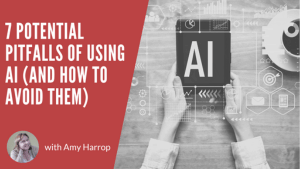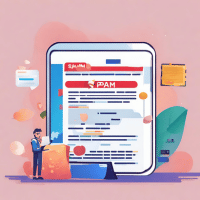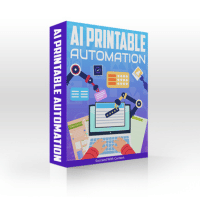 The rise of artificial intelligence (AI) has made content creation exciting and easy. It’s not surprising that so many content creators are enthusiastic about the potential of AI tools and what they can do. They can streamline content creation and increase profits if they’re used correctly.
The rise of artificial intelligence (AI) has made content creation exciting and easy. It’s not surprising that so many content creators are enthusiastic about the potential of AI tools and what they can do. They can streamline content creation and increase profits if they’re used correctly.
While the excitement is real, it’s not possible to talk about AI without also addressing some of the potential pitfalls that come with using it. While we probably don’t have to worry about a real-life version of Hal from 2001: A Space Odyssey or a Cylon uprising just yet, we should be mindful of some of the ways in which using AI can backfire if we’re not careful.
With that in mind, here are 7 potential pitfalls of using AI and some pointers to help you avoid them while still making the most of AI tools.
 #1: Factual Errors
#1: Factual Errors
A lot of people are using AI tools to write content. While AI can certainly provide a shortcut, it’s important to be aware of its limitations. As it currently stands, tools like ChatGPT can’t differentiate between current and outdated information. They may also occasionally make up information out of thin air, as two lawyers found out in June of 2023—an incident that cost their law firm $5,000 in fines.
While this pitfall won’t matter much when you’re writing product descriptions, it can make a huge difference when writing blog posts, articles, or guides. If you decide to use AI to write longer form content, you’ll need to make sure to do your own fact checking and editing to avoid mistakes that can impact the accuracy and authority of your content.
 #2: Derivative Content
#2: Derivative Content
Another potential pitfall of AI is that it is not inherently creative. It’s going to look at whatever source material it can find online and use that to write content or create images. As a result, the content it creates may be derivative of existing content.
While there’s nothing wrong with using other content as an inspiration, you’ll need to be careful that you’re not infringing on someone else’s copyright or trademark when you ask AI to create content for you. One way to do that is to take an image and use Google Lens to do a reverse image search. From there, you can refine the image until it’s unique to you.
 #3: Plagiarism
#3: Plagiarism
On a related note, there are plenty of examples of AI tools plagiarizing content that’s already been posted online. If you use AI-generated content that’s plagiarized, you could get in trouble in a variety of ways. For example, you would certainly be guilty of copyright infringement and might be sued or, at the very least, forced to remove your content. You could also get in trouble with Google because its algorithm will identify the duplication.
The best way to avoid plagiarism is to use a plagiarism checker after generating content with an AI tool. Some options include Grammarly and Copyscape, both of which can help you identify and rewrite plagiarized content.
 #4: Lack of Copyright Protection
#4: Lack of Copyright Protection
Copyright protection is essential whenever you post content online. In the United States, any content you create is protected under copyright as soon as you create it, but you must register your copyright if you need to file an infringement lawsuit. The problem with AI-generated content is that it is not copyrightable.
It’s important to note that you may copyright content that you create with the help of AI, but it needs to be original to be protected. In other words, you may not generate content with AI and use it as-is. Not only will you not have copyright protection, but there’s a risk that the AI you use could have provided identical or nearly identical content to someone else. Rewriting and adding your unique voice and ideas to what AI produces can help you protect your work.
 #5: Google Rank
#5: Google Rank
There’s been a lot of talk about using generative AI tools to help with search engine optimization (SEO). While there’s some benefit in doing so, it’s essential to understand how to do it properly to avoid being penalized by Google.
Google has announced that it is using AI-detection tools and will penalize websites and pages that use AI in violation of its spam policy. Specifically, they say that using AI to manipulate a page’s ranking in Google search results is a violation of their rules. The takeaway here is that any AI-generated content you use should meet Google’s people-first standards, displaying expertise, experience, authoritativeness, and trustworthiness.
 #6: Lack of Emotion
#6: Lack of Emotion
Appealing to your customers’ emotions and needs is an important part of content marketing. Because you have human emotions and understand them, it’s probably easy for you to connect with your customers on an emotional level when you write content or create designs. The same is not true of AI tools.
Some of the content created by AI may feel emotionally inauthentic. You can try to tell AI what tone to use but that may not be enough to avoid the issue. It’s up to you to rework the content to appeal to your audience’s emotions and make it sound authentic and empathetic.
 #7: AI Weirdness
#7: AI Weirdness
There’s simply no other way to say it: AI-generated content can be weird. Even a quick search may reveal a whole array of five-legged animals and people who look like they stepped out of the Uncanny Valley. The weirdness can be apparent in written content, too. As a content creator, it’s your job to be on the lookout for the weird and refine it until it isn’t weird anymore—unless weird is your goal, of course.
The best way to protect yourself here is to read over all content and edit it as needed and to review any AI-generated images before using them. That way, you can be sure that the content you share meets your standards and won’t drive your customers away.
 Automate AI Printable Creation
Automate AI Printable Creation
Generative AI and AI tools can be a huge help in streamlining content creation if you understand how to use them. Understanding the 7 potential pitfalls of AI we’ve listed here–and how to avoid them–will help you make the most of AI’s potential without putting yourself at risk.
Do you need help automating the AI printable creation process? Click here to learn about AI Printable Automation, with my full guide to AI content creation.



